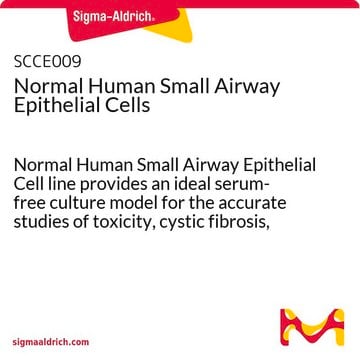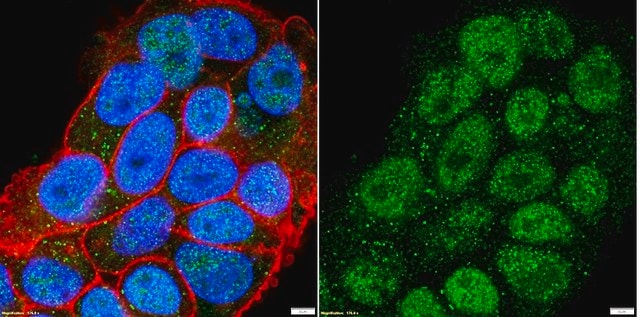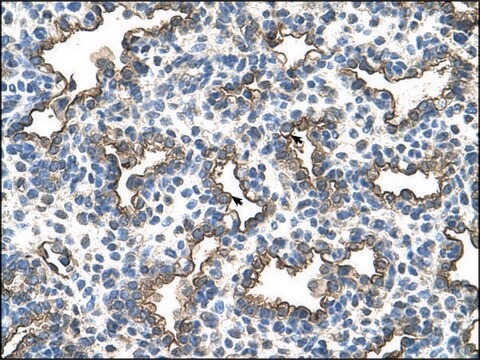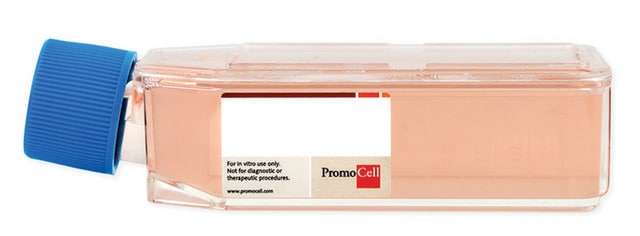C-12642
Human Small Airway Epithelial Cells (HSAEpC)
500,000 cryopreserved cells
Synonyme(s) :
HSAEpC cells
Se connecterpour consulter vos tarifs contractuels et ceux de votre entreprise/organisme
About This Item
Code UNSPSC :
41106514
Nomenclature NACRES :
NA.81
Produits recommandés
Source biologique
human (bronchiole)
Conditionnement
pkg of 500,000 cells
Morphologie
(epithelial)
Technique(s)
cell culture | mammalian: suitable
Maladie(s) pertinente(s)
asthma
Conditions d'expédition
dry ice
Température de stockage
−196°C
Catégories apparentées
Description générale
Lot specific orders are not able to be placed through the web. Contact your local sales rep for more details.
Human Small Airway Epithelial Cells (HSAEpC) serve as model cell culture systems for in vitro immune response studies. The 3D culture of HSAEpC mimics the in vivo cells effectively. The 3D cells are more viable, functional and efficient for immune response studies compared to the 2D cells.
Human Small Airway Epithelial Cells (HSAEpC) serve as model cell culture systems for in vitro immune response studies. The 3D culture of HSAEpC mimics the in vivo cells effectively. The 3D cells are more viable, functional and efficient for immune response studies compared to the 2D cells.
Primary Human Small Airway Epithelial Cells (HSAEpC) are isolated from the distal portion of the human respiratory tract in the 1 mm bronchiole area and are provided in a cryopreserved format. They stain positive for cytokeratin.The distal respiratory tract mainly consists of pulmonary alveoli, which are spherical outcroppings of the respiratory bronchioles and are the primary sites of gas exchange with the blood. HSAEpC are qualified for functional studies to investigate disorders such as asthma or pulmonary inflammation.
Origine de la lignée cellulaire
Bronchiole
Application
Human Small Airway Epithelial Cells (HSAEpC) may be used:
- in overexpression of αvβ6 integrin
- in cytotoxicity studies with Cannabis sativa oil extract
- in transfection studies with highly pathogenic avian influenza virus and influenza A virus
Qualité
Rigid quality control tests are performed for each lot of Epithelial Cells. They are tested for cell morphology, adherence rate and cell viability. Furthermore, flow cytometric analyses for the cell-type specific marker cytokeratin are carried out for each lot. Growth performance is tested through multiple passages under culture conditions without antibiotics and antimycotics. In addition, all cells have been tested for the absence of HIV-1, HIV-2, HBV, HCV, HTLV-1, HTLV-2 and microbial contaminants (fungi, bacteria, and mycoplasma).
Avertissement
Although tested negative for HIV-1, HIV-2, HBV, HCV, HTLV-1 and HTLV-2, the cells – like all products of human origin – should be handled as potentially infectious. No test procedure can completely guarantee the absence of infectious agents.
Procédure de repiquage
Click here for more information.
Autres remarques
Recommended Plating Density: 10000 - 15000 cells per cm2Passage After Thawing: P2Tested Markers: Cytokeratin positiveGuaranteed population doublings: > 15
Produits recommandés
Recommended Primary Cell Culture Media:Link
Clause de non-responsabilité
Ce produit, destiné à la recherche scientifique, est soumis à une réglementation spécifique en France, y compris pour les activités d′importation et d′exportation (Article L 1211-1 alinéa 2 du Code de la Santé Publique). L′acheteur (c′est-à-dire l′utilisateur FINAL) est tenu d′obtenir une autorisation d′importation auprès du Ministère français de la Recherche, mentionné à l′article L1245-5-1 II du Code de la Santé Publique. En commandant ce produit, vous confirmez détenir l′autorisation d′importation requise.
Code de la classe de stockage
12 - Non Combustible Liquids
Classe de danger pour l'eau (WGK)
WGK 1
Point d'éclair (°F)
Not applicable
Point d'éclair (°C)
Not applicable
Certificats d'analyse (COA)
Recherchez un Certificats d'analyse (COA) en saisissant le numéro de lot du produit. Les numéros de lot figurent sur l'étiquette du produit après les mots "Lot" ou "Batch".
Déjà en possession de ce produit ?
Retrouvez la documentation relative aux produits que vous avez récemment achetés dans la Bibliothèque de documents.
Effects of cannabis oil extract on immune response gene expression in human small airway epithelial cells (HSAEpC): implications for chronic obstructive pulmonary disease (COPD)
Mamber SW, et al.
Journal of Cannabis Research, 2, 5-5 (2020)
Rudra Bhowmick et al.
Tissue engineering. Part A, 24(19-20), 1468-1480 (2018-05-08)
Influenza A virus (IAV) claims ∼250,000-500,000 lives annually worldwide. Currently, there are a few in vitro models available to study IAV immunopathology. Monolayer cultures of cell lines and primary lung cells (two-dimensional [2D] cell culture) is the most commonly used
Swantje Thiele et al.
Cell reports, 31(3), 107549-107549 (2020-04-23)
Importin-α adaptor proteins orchestrate dynamic nuclear transport processes involved in cellular homeostasis. Here, we show that importin-α3, one of the main NF-κB transporters, is the most abundantly expressed classical nuclear transport factor in the mammalian respiratory tract. Importin-α3 promoter activity
Susann Kummer et al.
Viruses, 11(6) (2019-06-20)
Interferon-induced transmembrane proteins (IFITMs) have been shown to strongly affect influenza A virus (IAV) infectivity in tissue culture. Moreover, polymorphisms in IFITM3 have been associated with the severity of the disease in humans. IFITM3 appears to act early in the
Dong-Young Kim et al.
Frontiers in immunology, 11, 68-68 (2020-03-03)
Uncontrolled activation of transforming growth factor (TGF)-β results in a wide range of pathologic conditions. Therapeutic interventions to regulate TGF-β signaling during fibrosis have been developed but the effectiveness is still limited. Here, we show that developmental endothelial locus-1 (Del-1)
Notre équipe de scientifiques dispose d'une expérience dans tous les secteurs de la recherche, notamment en sciences de la vie, science des matériaux, synthèse chimique, chromatographie, analyse et dans de nombreux autres domaines..
Contacter notre Service technique








